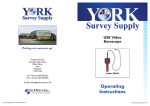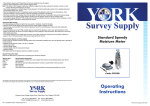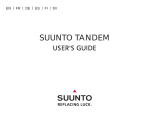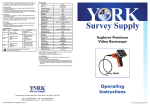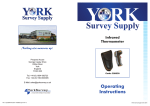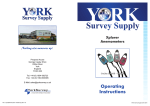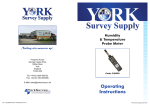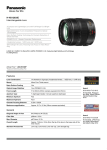Download Operating Instructions - York Survey Supply Centre
Transcript
All readings on the percentage scale are based on the horizontal distance. This means that if the distance on sloping terrain is measured along the ground, an error is introduced and this must be corrected for accurate results. The error is insignificant for most purposes at small ground slope angles but increases progressively as the angle increases. The trigonometrical correlation is H = h x cos a where H = the true or corrected height h = the observed height a = the ground angle With the aid of the above equation, the correction can also be made in the distance where h = the distance measured along the ground H = the horizontal distance sought. If the corrected distance is used, no correction in the height observed is needed. When calculating the horizontal distance by using the ground distance and slope angle, it must be pointed out that an error is introduced if the slope is measured from eye level to the pillar base. Measuring the slope along the ground would be cumbersome and inconvenient. No error is introduced, however, when the slope angle is measured from eye level to a sighting mark made or placed on the pillar at eye level (Fig. 11) whereby the two lines of measurement become parallel. the true angle of slope is 9 degrees. The example shown in Fig. 11 illustrates both methods of calculation. Nomographic Height Correction When the accompanying nomogram is used, all correction calculations become unnecessary. Only a ruler or some other convenient object with a straight edge is needed to obtain the nomographical solution. The nomogram is used by placing the ruler so that its edge intersects the angle scale on the left at the slope angle point and the observed height scale (on the right) at the pertinent point. The corrected height (or distance) is read at the point where the edge intersects the corrected height scale in the middle. When using a measuring distance of 20m or 100ft along the ground, the correction procedure becomes very simple. No slope angle measurement is then necessary. One needs only the reading of the top point and that of the ground point. Depending on the situation, their sum or difference gives the apparent height directly in feet. This is then corrected as follows: First, find on the right-hand scale in the nomogram the point indicating the apparent height. Secondly, find on the left-hand double scale the point indicating the ground point reading. Thirdly, connect these points. The corrected reading will be found from the pertinent middle scale at the point of intersection. In this procedure, the slope angle can be neglected as the left-hand ground point scale has been constructed so that both the ground slope angle and the average eye level height of 1.6m (5.5ft) have been taken into account. Suunto Tandem Combination Compass/Clinometer Fig.11. Calculating horizontal distance by using ground distance and slope angle Method 1: Measure the ground distance. This is found to be 25m (82ft). Then measure the slope angle. This is 9°. Read percentages of top and ground points. These are 29 and 23%. Calculate: 29 52 23 100 + 100 = 100 Take 52% of 25m (82ft). This is 13m (42.6ft). Multiply this by the cosine of 9°. 0.987 x 13m = 12.8m (0.987 x 42.6ft = 42ft) Method 2: Multiply the ground distance by the slope angle cosine (straight distance). 0.987 x 25m = 24.7m (0.987 x 82ft = 80.9ft). Add percentage readings as above and take the sum percentage of the corrected distance. 52 / 100 x 24.7m = 12.8m (52 / 100 x 80.9ft = 42ft). This example shows that a slope angle of 9° causes a correction of only 2.3% but when the slope angle is 35 degrees, the correction means a reduction of about 18% in the observed height. Code: 36027 Fig. 12. ISO 9001 SUUNTO Oy’s Quality Assurance System is certified by Det Norske Veritas to be according to the ISO 9001 in all SUUNTO Oy’s operations (Quality Certificate No. 96-HEL-AQ-220). Prospect House, George Cayley Drive, Clifton Moor, York, England YO30 4XE Tel: +44 (0) 1904 692723 Fax: +44 (0) 1904 690385 E-Mail: [email protected] www.yorksurvey.co.uk Ref:.. \operat98\instructions 15\36027.qxp 05-01-15 Operating Instructions ©York Survey Supply Centre 2015 Suunto Tandem Combination Compass/Clinometer Two Precision Instruments in One! Congratulations on your choice of the Suunto Tandem. The Suunto Tandem is all you need for both slope/height measurements and compass bearings. It is a liquid-filled precision compass and clinometer in one compact aluminium housing that is easy to use and rugged enough to protect against impact, corrosion and water. This top quality precision instrument combines precision accuracy with fast and easy one-hand operation. The pocket-size construction renders the Suunto Tandem most suitable for every type of work. Its unique shape makes it comfortable to hold in your hand. The optics of the Tandem can be adjusted to make the reading easier. The clinometer scale is in degrees and percent (0 - 90°, 0 - 150%) while the compass scale is azimuth (0 - 360° with reverse scale). Both the clinometer and the compass are graduated in 1°/1% increments and each is individually calibrated. The two edges at 90° angle make contact measurements possible, for example, when installing and positioning a satellite antenna. ADJUSTING OPTICS The optics of the Tandem can be adjusted by turning the eyepiece with your fingers as shown in Figure 1. Adjust the eyepiece so that both the hairline and the scale are sharp and the eyepiece slot settles in a vertical position in the bearing compass and in a horizontal position in the clinometer. CLEANING THE TANDEM In the case humidity or dirt develop inside the Tandem, it can be cleaned by removing the detachable eyepiece. The eyepiece can be removed by rotating it counter-clockwise (Fig. 2). Rinse with clean water, allow to dry and carefully reassemble the eyepiece. BEARING COMPASS Construction The bearing compass is designed to combine extreme accuracy with ease and speed of operation. The card is supported by a jewel bearing and is immersed in a dampening fluid, giving vibrationless, smooth movement. The compass has been given permanent antistatic treatment. Inclination - Balancing The compass card is balanced to correspond to the area within which the compass is used. When using the compass elsewhere (e.g. on trips abroad) the change of the vertical magnetic field could make the compass card dip and this may cause difficulties in taking the bearing. The balancing zone (see Fig. 4), if other than 1, is indicated on the back of the instrument below the serial number - contact York Survey Supply Centre for details. Fig. 2. Removing the eyepiece CONTACT MEASURING The Tandem can be used for aligning satellite dish antennae or for other types of contact measuring. The clinometer incorporates two different contact edges (see Fig. 3) which enable the measurement to be made compared to the horizontal or vertical plane. The scale (0 - 90 - 0 degrees) can be used in contact measuring and it gives the angle of the surface compared to the contact plane. Fig. 3. Edges for contact measurement Ref:.. \operat98\instructions 15\36027.qxp 05-01-15 The task is to measure the height of a pillar at a distance of 25m (82ft) on level ground (Fig. 8). The instrument is tilted so that the hairline is seen against the pillar-top (apex). The reading obtained wil be 48% (ca. 25½°). As the distance is 25m (82ft), the height of the pillar is 48 / 100 x 25 = ca. 12m (48 / 100 x 82 = ca. 39ft). To this must be added the eye’s height from the ground, e.g. 1.6m (5½ft). Their sum is 13.6m (44½ft), the height of the pillar. Declination The compass reads magnetic north, which differs from true north by the amount of the local declination which is printed on your map. In order to lay out on a map a bearing obtained with the compass, the plus or minus declination for the locality in question must be added to or subtracted from the compass bearing. Deviation Iron and steel objects close to the compass, like a wristwatch or steelrimmed spectacles, may cause deviation. Whenever possible, remove such objects to a safe distance. Large structures like buildings, reinforced concrete quays etc. will cause deviation at some distance. A reverse sighting from the opposite end of the target line will show up any deviation present. Caution: Do not use detergents or solvents of any kind as they might cause damage to the capsules. horizontal plane at eye level. The right-hand scale gives the height of the point of sight from the same horizontal eye level, and it is expressed in percent of the horizontal distance. The following example illustrates the procedure. Fig. 8. Measuring height of a pillar Fig. 4. The balancing zones Fig.1. Adjusting optics The instrument can also be used for triangulation (see Fig. 6). The bearings obtained from the main scale are 0° against the hill and 64° against the curve of the road, or 180° and 244° on the reverse scale. Your own location is indicated by the intersection point of these two lines. When performing very accurate positioning tasks, the bearings obtained have to be corrected for local declination. Operation With both eyes open, aim the compass so that the hairline is superimposed on the target, when viewed through the lens. The main scale (large numbers) gives the bearing from your position to the target, the small numbers give a reverse bearing from the target to your position. This feature is of great assistance when calculating a precise position. Use the left or the right eye as preferred. With both eyes open, an optical illusion makes the hairline appear to continue above the instrument frame, superimposed on the target. This improves reading accuracy and speed. Because of an eye condition called heterophoria, the reading accuracy of some users may be impaired. Check for this as follows: Take a reading with both eyes open and then close the free eye. If the reading does not change appreciably there is no disalignment of the eye axes, and both eyes can be kept open. Should there be a difference in the readings, keep the other eye closed and sight halfway above the instrument body. The hairline now rises above the instrument body and is seen against the target (Fig. 5). Fig. 5. The hairline is seen against the target Fig. 6. Triangulation The co-tangent table at the back of the Tandem can be utilised for distance calculations, and especially for locating position in cases where two landmarks are visible at a narrow angle. This procedure is also illustrated in Fig. 6. The angle between the curve of the road and the oil derrick is 15°. A line is drawn at a 90° angle to the 64° bearing line from the curve of the road toward the oil derrick bearing line. the distance, as measured on the chart, is 1.6km (1 mile). Then your position is cot 15° x 1.6km (cot 15° x 1 mile = 3.7 miles) along the corrected bearing line of 64°. CLINOMETER Construction The scale card is supported by a jewel bearing assembly and all moving parts are immersed in a damping liquid inside a high strength, hermetically sealed plastic container. The liquid dampens all undue scale vibrations and permits a smooth, shockless movement of the scale card. Instructions for Use Readings are usually taken with the right eye. Owing to differences in the keenness of the sight of the eyes and because of personal preferences, the use of the left eye is sometimes easier. It is of prime importance that both eyes are kept open. the supporting hand must not obstruct the vision of the other eye. The instrument is held in front of the reading eye so that the scale can be read through the eyepiece and the round side window faces to the left. The instrument is aimed at the object by raising or lowering it until the horizontal hairline is sighted against the point to be measured. The position of the hairline now on the scale is the reading. Owing to an optical illusion, the hairline (cross-hair) seems to continue outside the housing and is thus easily observed against the sighted object (Fig. 7). In very exact measurements, and particularly on sloping ground, two readings are taken: one to the top, the other to the base of the pillar. When the pillar base is below eye level, the percentages obtained are added. The total height is the sum percentage of the horizontal distance. For example (Fig. 9), if the apex reading is 41% and the ground reading is 13%, the total height of the pillar, measured from a distance of 25m (82ft), is (41+ 13) / 100 x 25m = 54 / 100 x 25m = ca. 13.5m [(41 + 13) / 100 x 82ft = 54 / 100 x 82ft = ca. 44½ft]. Fig. 9. Taking two readings When the pillar base is above eye level, the base reading is subtracted from the apex reading, and the total height is the difference percentage of the horizontal distance. For example (Fig. 10), if the apex reading is 64% and the base reading 14%, the total height is (64 - 14) / 100 x 25m = 50 / 100 x 25m = 12.5m [(64 - 14) / 100 x 82ft = 50 / 100 x 82ft = 41ft]. When calculations are made mentally, it is advisable to use measuring distances of 50, 100 or 200 ft, for the sake of simplicity Fig. 7. The hairline indicates the reading The left-hand scale angle gives the slope angle in degrees from the Fig. 10. Pillar above eye level ©York Survey Supply Centre 2015


